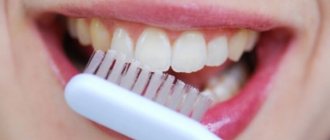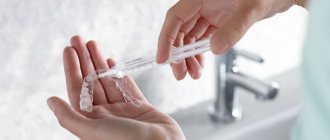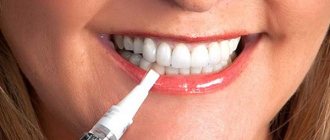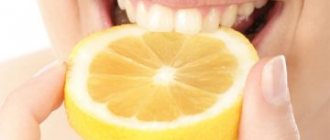One of the most popular and quite effective ways to whiten teeth at home is whitening with hydrogen peroxide. It is worth noting that this substance is also used by dentists for whitening in a stationary dental clinic. True, there it is not used in its pure form, but in combination with various components that reduce the destructive effect of peroxide on tooth enamel. For example, with remineralizing gels that contain glycerin. Many people also whiten their teeth with healing tea tree oils.
Therefore, when using peroxide yourself at home, you need to be careful.
Is it possible to whiten teeth with hydrogen peroxide?
With age, every person's tooth enamel becomes thinner and becomes covered with roughness that is invisible to the naked eye.
As a result of smoking, regular consumption of food containing dyes, as well as drinking coffee and tea, a kind of pigmented film is formed on the surface of the teeth, tightly attached to the rough surface of the teeth. It is impossible to remove it with even the most expensive paste, so to restore a beautiful smile, it is necessary to periodically carry out the whitening procedure. In order not to harm the enamel, it is better to entrust such a procedure to specialists. However, if this is not possible, you can resort to gentle remedies at home.
When the need arises to whiten teeth at home, many people use hydrogen peroxide. This product really works as an effective bleach and can eliminate yellow plaque, age spots and darkening.
Dentist on the advantages and disadvantages of teeth whitening with peroxide:
Operating principle
Penetrating into the enamel and dentin of the tooth, the drug reacts with dental tissues, releasing oxygen, which causes organic substances to break down into simpler compounds. Thus, oxygen helps remove plaque.
Sometimes peroxide is used as an antiseptic - for colds, it is used to gargle. For such rinses, a weakly concentrated solution is used, which does not affect the enamel, but also does not have a whitening effect.
How peroxides whiten dentin
Hydrogen peroxide
Hydrogen peroxide molecules easily penetrate the enamel, releasing active oxygen and oxidizing pigmented dentin. It brightens and, shining through the enamel, makes teeth visually whiter.
Urea peroxide
Carbamide peroxide whitens teeth according to the same principle: when it breaks down, hydrogen peroxide is formed, which gives the desired effect. But the reaction rate of carbamide peroxide is lower. Therefore, the impact on the teeth should be longer. However, the mucous membrane is less irritated. If you have sensitive gums, choose products with carbamide peroxide.
Indications for use
The whitening procedure is indicated in the following cases:
- Yellowing of the enamel due to heavy smoking, drinking large amounts of coffee and tea.
- Regular use of medications containing fluoride. Such preparations include toothpastes and preventive gels with a high content of this microelement. They can only be used periodically, as prophylactic agents.
- Long-term use of tetracycline group medications.
- Yellowing of the enamel color as a result of natural aging of the body.
Preparing your teeth
Since the whitening procedure is quite harmful to tooth enamel, before starting it, measures should be taken to minimize the likelihood of negative consequences.
First of all, visit a dentist who will determine the condition of your teeth and enamel. Any manipulations using peroxide can only be carried out by those people who have thick and fairly durable enamel.
The dentist will examine the teeth, identify areas with darkening and yellowing and determine the nature of their origin. If the yellowness is not outside, but inside the tooth, then peroxide will not give the expected whitening result.
Whitening Tips
If you want to try any of the methods listed above, visit your dentist first. He must conduct an examination and make sure there is no caries, as well as other diseases.
Try rinsing with peroxide: it is the most gentle on your teeth.
Sometimes peroxide of the required concentration is not available for sale. You can purchase perhydrol (used externally to disinfect wounds and inflammatory skin lesions) at the pharmacy and dilute the solution to make 3% peroxide. Do it right. Mix the products in the following proportions: for 9 g of perhydrol - 100 ml of water (distilled).
Attention! Using the product in a higher concentration leads to burns of the mucous membrane and damage to the enamel!
Whitening at home
There are quite a few different ways to lighten teeth with peroxide, and they all have a good effect.
Important! Only 3% peroxide is allowed to be used, since more concentrated solutions will inevitably lead to damage to the enamel.
Peroxide rinse
Rinsing with pure peroxide is one of the simplest methods, so it is recommended for people who are limited in time.
Thus, the rinsing procedure takes no more than 5-10 seconds, which is very convenient if you are in a hurry to work in the morning and do not have the opportunity to spend time preparing the compositions. You should not keep the product in your mouth for more than 10 seconds - this will help minimize the risk of damage to the enamel. During the procedure, tingling and some burning may occur - this is absolutely normal, so there is no need to worry. After rinsing, you need to moisten a cotton swab in the preparation and gently wipe the problem areas.
Then rinse your mouth with warm water and refrain from eating or drinking anything for at least 30 minutes.
For prevention purposes, this method is recommended to be used once a week. If you need to lighten your teeth and remove pigment plaque, rinse your mouth once a day. As a rule, this procedure works quickly and the effect becomes noticeable after 2-3 weeks.
Brushing with a toothbrush
This method also does not take much time and effort.
Whitening is carried out in three stages:
- First, brush your teeth with a toothpaste that contains fluoride.
- Then mix warm water and peroxide in equal proportions in a glass and, dipping the brush into the glass, brush your teeth for 1 minute.
- Rinse your mouth and refrain from eating or drinking anything for the next 30 minutes after the procedure.
Soda mixture
Baking soda is an excellent bleaching agent.
There are recipes for teeth whitening using only soda. When used in combination with peroxide, you will get maximum benefit and visible results. The process itself is performed as follows:
- First of all, prepare a thick paste from peroxide and soda.
- Then apply it to the surface of your teeth. You can use a cotton swab or your fingers to do this.
- Leave the mixture on your teeth for 3 minutes, then rinse your mouth with warm water.
- Afterwards, brush your teeth using fluoride toothpaste.
When using soda and peroxide, it is important to adhere to the following rules :
- Do not use a toothbrush, especially one with hard bristles, to apply the mixture.
- Avoid contact of the mixture with mucous membranes and gums.
- Do not allow the mixture to come into contact with your teeth for more than 3 minutes.
A blogger tries to whiten teeth using a similar recipe:
With water
The whitening process consists of three stages:
- Brushing teeth using fluoride toothpaste. It has a protective effect on the enamel and prevents it from damage.
- Next, you will need to prepare a rinse. For this purpose, mix peroxide with boiled water in equal proportions. Rinse duration is one minute.
- Finally, rinse your mouth with plain water, which will wash away any remaining medication. It is not recommended to consume food or drinks for 30 minutes after the procedure.
With pasta
In a small container, mix peroxide and toothpaste in equal proportions and use the resulting mixture in the morning to brush your teeth.
Soda and salt solution
To properly prepare the solution, you will need :
- 1 part peroxide.
- 2 parts water.
- A pinch of salt.
- A pinch of soda.
Rinse your mouth with the resulting solution for 1 minute.
With tooth powder
Dip the brush in tooth powder and gently apply 2-3 drops of peroxide on top. After this, you need to brush your teeth as usual and rinse your mouth with water.
Soda, hydrogen peroxide, lemon
Prepare a paste of 2-3 drops of lemon juice, peroxide and soda. Apply the mixture to a soft toothbrush and gently brush your teeth.
Video on the topic:
Rinsing your mouth with peroxide
The solution and soda can be used both in combination and separately. For example, for fresh breath and gentle, but not instant, whitening, hydrogen peroxide should be mixed with water 1:1 and rinsed with water for several minutes. Then spit it out (do not swallow) and rinse with water. After this, do not drink or eat for about 30 minutes.
Soda is used in the same way. As the only component for cleaning teeth, or mixed with toothpaste. This method of whitening has many contraindications, which are described below.
Peroxide based gels
Today on sale you can find special gels containing hydrogen peroxide and a special substance - urea, which, due to its properties, promotes the active production of oxygen when in contact with air.
Among the most common whitening gels are:
- White Perfect - this product is often used by professional dentists, which confirms that it meets all safety requirements.
- Brilliant is a gentle product, suitable for those with sensitive enamel.
- Teeth Whitening Pen - the product is available in the form of a pencil with a brush, which greatly facilitates the application process.
- White Light is a gel designed for use with mouth guards and a UV lamp. Those who decide to use this particular drug will have to take care of purchasing a lamp and cap.
How safe is the procedure?
The use of this remedy gives good results, relieving people from the consequences of excessive consumption of coffee, tea, various “coloring” drinks and food, as well as cigarettes. However, you should not abuse it in order to prevent possible unpleasant consequences.
Possible consequences
- Increased sensitivity
. This refers to the sensitivity of the teeth themselves, discomfort when eating very hot or cold things. It is observed in almost everyone who uses similar techniques.The reason is that there is thinning of the enamel. This phenomenon can be eliminated by using one of the special pastes that help saturate the tissues with essential minerals and locally block the reactions of nerve endings.
- Chalked teeth
.Photo: coated teeth
This is the so-called over-bleaching. It occurs very rarely and only in those people who use soda and peroxide constantly and for a long time, without taking breaks.
The top layer of enamel is initially shiny, but in this case it practically wears off, revealing the inner layers of the tooth, which look like a coated wall and have no shine.
You won’t be able to get rid of this on your own; you need to seek help from professional dentists.
- Demineralization process
. If small white spots appear on the surface of the teeth, which become more and more noticeable over time, then the process of enamel losing essential minerals has begun, which leads to its destruction. Modern dentistry has ways of carrying out the reverse process, that is, enriching the enamel with minerals.
Irritation of the gum mucosa may also occur, but in most cases it is short-lived and goes away very quickly after thorough rinsing.
Precautionary measures
- Before using peroxide, you need to do a sensitivity test by applying the product to the inside of the elbow.
- Peroxide is a very strong oxidizing agent. It can not only lighten teeth, but also increase their sensitivity. Therefore, people who experience discomfort or painful sensations on their teeth while eating hot or very cold food should avoid using this product.
- Also, people with periodontal disease, caries and teething wisdom teeth should not use this product.
- Peroxide should not be used by children under 12 years of age, since their tooth enamel is still developing and is not very dense. Pregnant women and people who wear braces or crowns should avoid using peroxide as a teeth whitener.
Reference! You can use peroxide for teeth whitening no more often than 1 course, consisting of 2-3 weeks, every 2-3 months.
Possible risks
A procedure such as teeth whitening with peroxide at home must be approached wisely. It is important to remember that the product can cause increased sensitivity of the enamel and lead to weakening of hard tissues. If you do not take into account the contraindications described above, you can cause severe irritation, aggravate caries and gingivitis, and also provoke an inflammatory process.
If the product comes into contact with the gums, it can cause allergies, chemical burns, and even cause gum recession. After the procedure, the gums may turn white, bleed, hurt, and burn severely.
Effect of use
The effect of lightening the color of teeth by 1-2 shades will occur already 2-3 weeks after the start of the procedures. To prevent repeated darkening of the enamel, it is advisable to repeat the procedure at least 2-3 times a year.
Possible negative consequences
When using peroxide, you need to be careful not to harm your dental health. Thus, an incorrectly performed procedure can cause bleeding gums as a result of a chemical burn.
If you have a filling, you should take into account that if it does not fit tightly, peroxide can penetrate inside the tooth, which will lead to accelerated destruction.
Experiment using peroxide for whitening:
Contraindications
Using any means to whiten tooth enamel can either help or harm. Before you start using them, you should consult with your dentist and take into account the characteristics of your oral cavity.
There are a number of contraindications for using cleaning and whitening teeth with soda, peroxide and lemon. These include:
- Bleeding gums, periodontal disease.
- Presence of oral diseases.
- Thin enamel - soda with abrasive particles erases its top layer.
Advice. To achieve the desired effect when whitening your teeth, you should remember that their natural color is slightly yellowish. You shouldn’t go against nature and make it unnaturally snow-white. This is fraught with further dental problems. Once visible results are achieved, use whitening methods no more than once every two to three months.
Remember - it is easier to destroy than to build. Love yourself and take care of your teeth!
Advantages and disadvantages
The method has both advantages and some disadvantages. Benefits include :
- Availability.
- Efficiency.
Among the disadvantages are:
- The presence of a large number of contraindications.
- High probability of enamel injury.
Contraindications
The use of this drug is contraindicated in the following cases :
- Diseases of the oral cavity occurring in the acute stage.
- Caries, periodontal disease.
- Presence of braces or other orthodontic systems.
- Weak enamel.
- Age up to 12 years.
In the absence of the listed contraindications, it is still advisable to consult a dentist and carry out the procedure only with his consent.
Precautions when working with the substance
There are certain precautions when working with peroxide to avoid tissue damage:
- The soda mixture with peroxide is applied to the fabric for no more than 5 minutes.
- Do not soak delicate materials in hot water with peroxide.
- To enhance whitening, do not add commercial bleaches.
- Do not remove rust stains with peroxide to avoid ruining your clothes.
- Use only 3% product, 10% concentrate and higher - cause skin corrosion. In case of contact with skin, rinse immediately with plenty of water. If swelling and hyperemia persist, you should consult a doctor.
- Avoid splashing peroxide on mucous membranes, mouth and eyes to avoid chemical burns.
- Wash with rubber gloves in a ventilated area.
By following these recommendations, you will avoid unpleasant consequences of work. To avoid spoiling the material, try the folk remedy on a small area.
The article has been verified by the editors
Reviews from doctors and patients
- Lyudmila B: Recently I had an urgent need to whiten my teeth. I didn’t have time to go to the dentist, so I decided to try a recipe with peroxide, salt and soda. I didn’t expect that simple home remedies could completely clean and improve the appearance of teeth in just one go. However, I want to warn you: I decided to take a 7-day course, and already on the fifth day my teeth became very sensitive to cold and hot foods.
- Dmitry K: A friend recommended the method of teeth whitening using peroxide. The fact is that I am a heavy smoker, and, accordingly, the color of my teeth leaves much to be desired. The result pleased me: a week after brushing with toothpaste enriched with peroxide, my teeth became noticeably lighter.
- Irina, dentist: For some people, yellowish or grayish teeth are their natural color. And when trying to whiten such teeth, you can cause irreparable harm to their health. In addition, there are a number of contraindications for the use of peroxide, neglect of which also leads to disastrous results. Therefore, I recommend that my patients carry out the whitening procedure only in dental clinics, where special gentle products and professional equipment are used.
Advice from Dr. Zubastik
Have you decided to undergo home whitening procedure? Your steps:
- Visit your dentist.
- Treat pockets of caries.
- Check the condition of the gums: there are no bare areas, deep pockets, or inflammation.
- Consult your doctor.
- For lightening, use only a 3% peroxide solution diluted with water.
- Restore enamel: buy a paste with a high fluoride content.
The main thing is not to get carried away! Doctors do not always welcome whitening even in dental offices: the procedure has many contraindications, and it is even more dangerous to do it at home, without the supervision of a doctor.
If you take care of your teeth, undergo preventive examinations twice a year and coordinate all your actions with specialists. Remember: a snow-white smile is not always an indicator of health, and sometimes achieving it with any effort can be dangerous.
Tags: folk remedies, whitening, hydrogen peroxide
About the author: Dr. Zubastik
Typically, a toothache begins to subside on the way to the clinic and finally goes away after 10 minutes of sitting in line to see the dentist.
- Related Posts
- Teeth whitening with coconut oil: recipe with photos (+ reviews)
- How to get rid of caries at home?
- How to relieve toothache at home: 5 ways to quickly get rid of pain
« Previous entry









